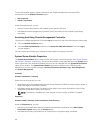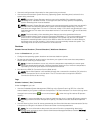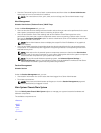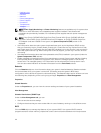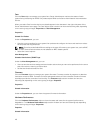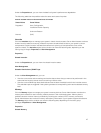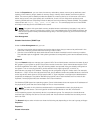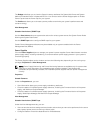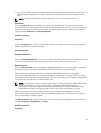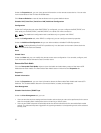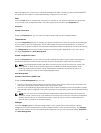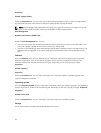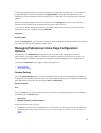
Under the Properties tab, you can view the memory redundancy status, memory array attributes, total
capacity of the memory arrays, details of memory arrays, memory device details, and memory device
status. The memory device details provides the details of a memory device on a connector such as the
status, device name, size, type, speed, rank, and failures. A rank is a row of dynamic random access
memory (DRAM) devices comprising 64 bits of data per Dual Inline Memory Module (DIMM). The possible
values of rank are single, dual, quad, octal, and hexa. The rank displays the rank of the DIMM
and helps in the easy service of DIMMs on the server.
NOTE: If a system with spare bank memory enabled enters a redundancy lost state, it may not be
apparent which memory module is the cause. If you cannot determine which DIMM to replace, see
the switch to spare memory bank detected log entry in the ESM system log to find which memory
module failed.
Alert Management
Subtabs: Alert Actions | SNMP Traps
Under the Alert Management tab, you can:
• View the current alert actions settings and set the alert actions that you want to be performed in the
event that a memory module returns a warning or failure value.
• View the current SNMP trap alert thresholds and set the alert threshold levels for memory modules.
The selected traps are triggered if the system generates a corresponding event at the selected severity
level.
Network
Click the Network object to manage your system's NICs. Server Administrator monitors the status of each
NIC present in your system to ensure continuous remote connection. Server Administrator reports FCoE
and iSoE capabilities of the NICs. Also, NIC teaming details are reported if they are already configured on
the system. Two or more physical NICs can be teamed into a single logical NIC, to which an
administrator can assign an IP address. Teaming can be configured using NIC vendor tools. For example,
Broadcom — BACS. If one of the physical NICs fails, the IP address remains accessible because it is bound
to the logical NIC rather than to a single physical NIC. If Team Interface is configured, the detailed team
properties are displayed. The relation between physical NICs and Team Interface and vice versa is also
reported, if these physical NICs are members of the Team Interface.
On Windows 2008 Hypervisor operating system, Server Administrator does not report the IP addresses of
the physical NIC ports that are used to assign an IP to a virtual machine.
NOTE: The order in which devices are detected is not guaranteed to match the physical port
ordering of the device. Click the hyperlink under Interface Name to view NIC information.
In ESXi operating system, the network device is considered a group. For example, the virtual ethernet
interface that is used by the Service Console (vswif) and virtual network interface that is used by vmknic
device on ESXi.
The Network object action window can have the following tab, depending on the user's group privileges:
Properties.
Properties
Subtab: Information
48



